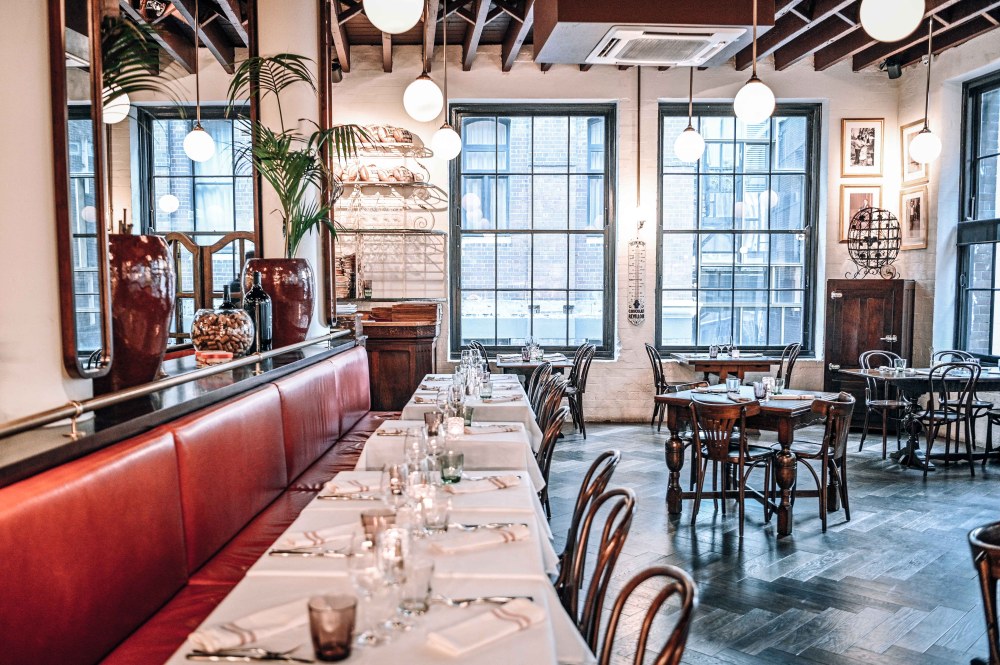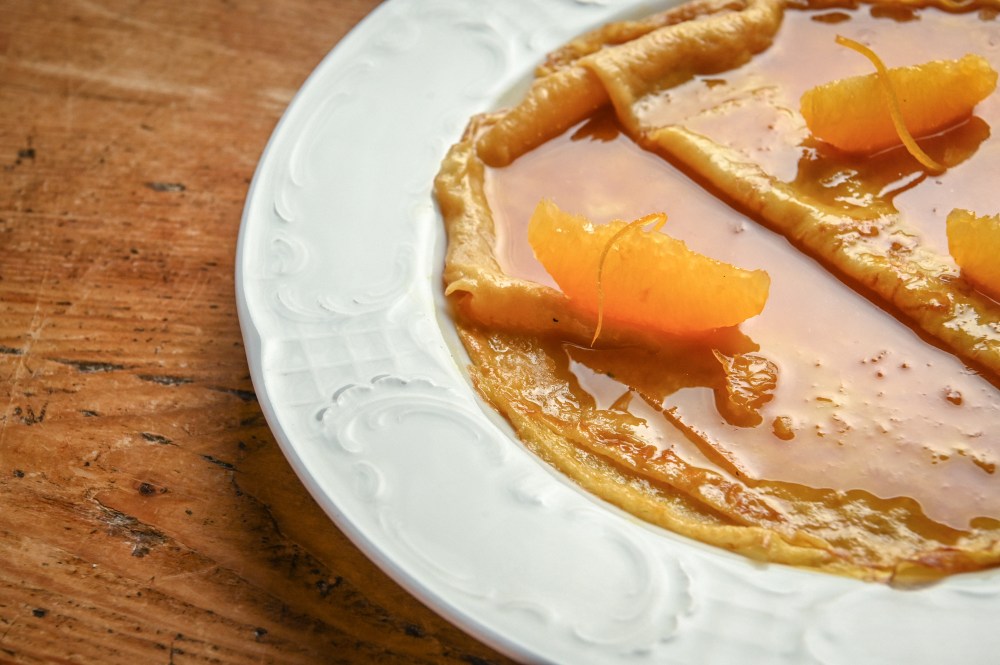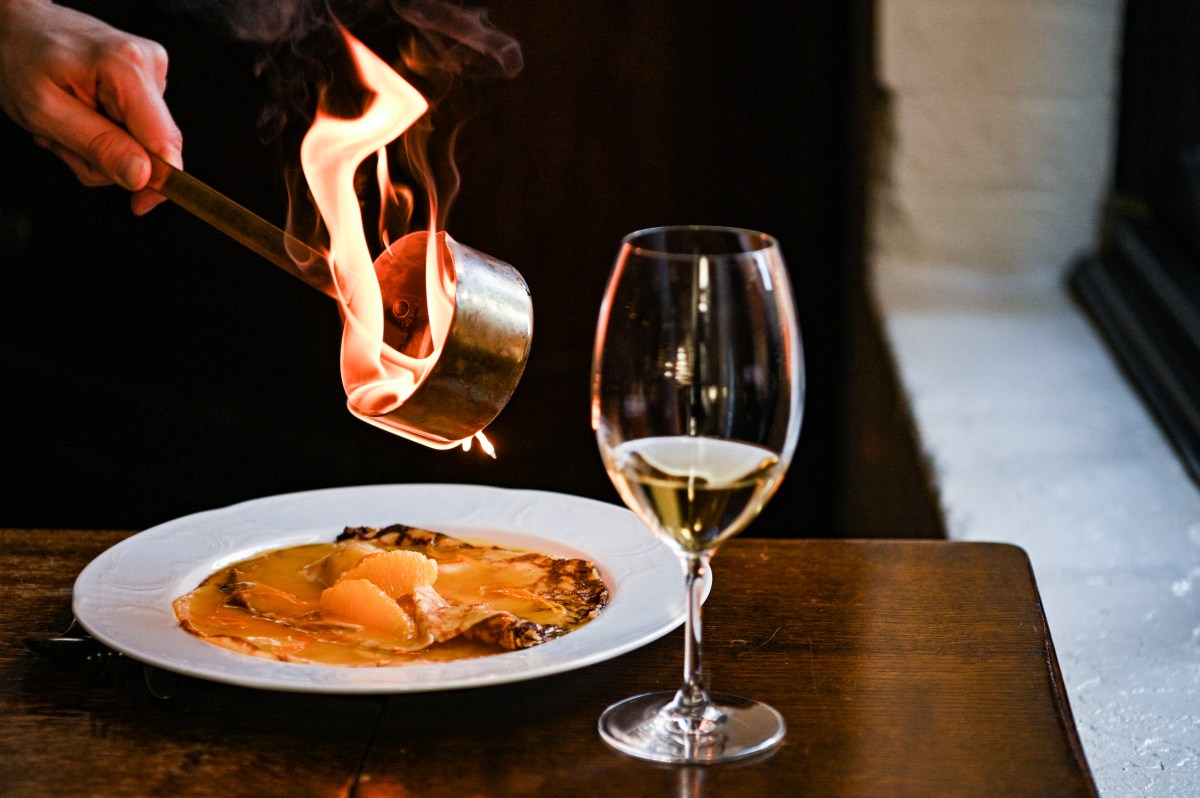When it comes to French desserts, crêpes Suzette is a dish that has cemented its place as a classic, combining a methodical cooking process with a sublime flavour combination and all-round elegance on the plate. Unlike crème brûlée or crème caramel, crêpes Suzette sits on the fruitier end of the sweet scale thanks to its citrus-forward profile.
But crêpes Suzette is perhaps most recognisable by its theatrical presentation. The dish is laced with liquor and set alight at the table, resulting in a memorable
finish to a dining experience.
Hospitality speaks to Batiste Gouraud, head chef at Gavroche, and Markus Andrew, executive pastry chef at Bistro Nido, about the process behind making the dessert, the importance of balance, and how they’re introducing modern hints to the staple.
There are a few origin stories when it comes to the starting point of crêpes Suzette. The most common is the accidental creation of the dish by Henri Charpentier who served the Prince of Wales at Monte Carlo’s Café de Paris in 1895. Charpentier recounts the moment in his autobiography Life A La Henri — Being The Memories of Henri Charpentier: “It was quite by accident as I worked in front of a chafing dish
that the cordials caught fire,” the recount reads. “I thought it was ruined. I tasted it. It was, I thought, the most delicious medley of sweet flavours I had ever tasted.”
The story continues with the Prince of Wales naming the dish crêpes Suzette after the lady he was dining with. Larousse Gastronomique disputes the story and attests Charpentier would’ve been too young to be serving the Prince of Wales. However, the book agrees he popularised the flambéed element of the dish.
Another account says it was named after Princess Suzette de Carignan, who requested it for French King Louis XV. Others believe it was created by a German chef at Restaurant Marivaux who made it for French actress Suzanne ‘Suzette’ Reichenburg
who played a maid that served crêpes in a play performed at the Comédie-Française.
While the origins of the dish are disputed, the dish has long been a mainstay at French restaurants and beyond — Gavroche in Sydney’s Chippendale is one of them. “Crêpes Suzette is a deceptively simple dessert that requires a certain level of skill to master,” says Head Chef Batiste Gouraud who grew up in Bretagne, France.
Gavroche’s menu pays homage to French bistros, which means crêpes Suzette is a natural fit. “Our menu is designed around traditional French cuisine, so crêpes Suzette made sense to include as it’s one of the most prestigious French desserts.”
Markus Andrew is a classically trained pastry chef who studied at Le Cordon Bleu before going on to lecture at the culinary school. Crêpes Suzette is one of the dishes he has taught pupils. “The students loved the learning experience of flambéing crêpes Suzette during the afternoon tea lesson,” he says. It’s also been served at Devon Hospitality Group’s Devon Café in Jakarta, and is on the menu at its latest venue Bistro Nido in Sydney’s Regent Place.
But Andrew is putting a twist on the classic recipe in line with the menu’s French–Japanese approach. “The Bistro Nido version of crêpes Suzette is made with the concept of respecting tradition with Japanese sensibility in mind,” says Andrew. “I have maintained the traditional method and I believe a good dish must be rooted in the classic.”

The traditional crêpes Suzette consists of three elements: crêpes, orange sauce, and flambéed alcohol. The process begins with the crêpe. For the batter, Gouraud starts with mixing flour, sugar, and eggs before adding in milk and combining until smooth. Melted butter is added to the batter before it’s left to rest in the fridge for at least six hours.
“The wheat proteins that make up gluten combine as they swell while the batter rests,” says Gouraud. “It [makes] the batter light and fluffy, creating a softer final product. Without resting, the batter would be more brittle.” While the batter rests, it’s time to make the orange sauce, which Gouraud says ties the elements and the flavours of the dish together.
“The finished sauce is a smooth and syrupy consistency with a velvety texture,” he says. “It enhances the flavour of the crêpes while adding sweetness and tanginess from the orange zest.” To create the sauce, he starts with a dry caramel and caramelises it
before adding butter, fresh orange juice, and orange zest. It is then cooked over an extended period to deepen its profile. “It typically takes around 10 minutes to prepare but over an hour to cook as we’re quite meticulous with the flavours,” says Gouraud.
Over at Bistro Nido, the traditional orange is swapped out for a different citrus — mandarin. “Growing up, I visited an orchard and picked mandarins with my family almost every year in Chittering, Western Australia,” says Andrew. “Mandarin contributes more natural sweetness, juiciness, and a unique aroma to the dish.” Mandarin, or unshu mikan, is a popular fruit in Japan, too, which is in line with the venue’s fusion approach.
After the batter has rested and the sauce is completed, the crêpes are cooked. Gouraud says choosing the right pan is vital to achieving an unrivalled crêpe. “The pan should be cast-iron or cast aluminium and needs to be circular for even distribution of
heat, so each crêpe is cooked perfectly.” Butter is added to the pan before the batter is poured in and the crêpes are cooked for one minute on each side or until they are “thin, marbled, and light” according to the chef.
Andrew cooks crêpes by adding butter and three tablespoons of batter to a skillet, quickly tilting it to distribute the mixture. The chef cooks the crêpes for around 45 seconds until the edges curl up and start to brown before flipping them with a long spatula. He continues to cook the crêpes for another 10–15 seconds until brown spots appear across the bottom.
Once cooked, two crêpes are folded and covered with the heated sauce and garnished with fresh orange and citrus zest. The final element of crêpes Suzette is the addition of alcohol which plays a vital role in flavour, but also in the theatrical serving of the dish. Traditionally, the French Cognac Grand Marnier or orange-flavoured liqueur Curaçao is used. Gouraud and Andrew both prefer Grand Marnier. “We finish the sauce with Grand Marnier to add a subtle depth and warmth so it’s sweet and strong with a zesty orange flavour,” says Gouraud. The dish is then flambéed tableside for guests, where the alcohol is set on fire with a lighter and remains lit for a short time before it extinguishes.

Gouraud’s menu also offers guests the option to order housemade vanilla ice cream on the side which he says is a common but not so traditional addition. “Some people also like to add Chantilly, depending on their taste preference,” says the chef. “Personally, I love the combination of the two elements and find the creaminess of the ice cream a nice way to contrast the flavours of the crêpes and sauce.”
Bistro Nido serves crêpes Suzette with a similar tableside flambé experience. Mascarpone cream is also served with the dish for an extra layer of complexity. “I wanted to add more texture and richness and balance it out with the acidity and freshness of the sauce and the fruit,” says Andrew.
Crêpes Suzette is a showcase of French artistry when it comes to the creation of classic desserts. It also brings a sense of entertainment and tradition to the dining experience for guests. For Andrew, the traditional element, along with the flavour profile, is why he enjoys serving the dish. “I like how it retains the classical flavour of crêpes Suzette with the freshness of the citrus fruit served with the old charm gueridon,” he says.
Gouraud also sees an element of nostalgia in the dish and believes it’s a great way to end a dining experience. “It reminds me of my grandma who used to make crêpes Suzette back home in France,” he says. “It’s also a great way to finish your meal and
helps enhance the experience for the customer as they get to see it flambéed in front of them.”

